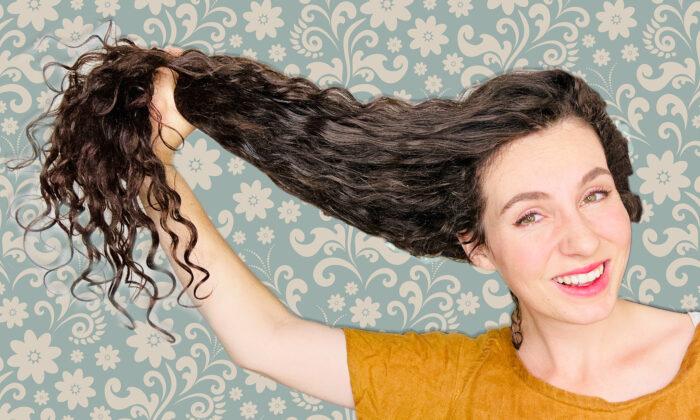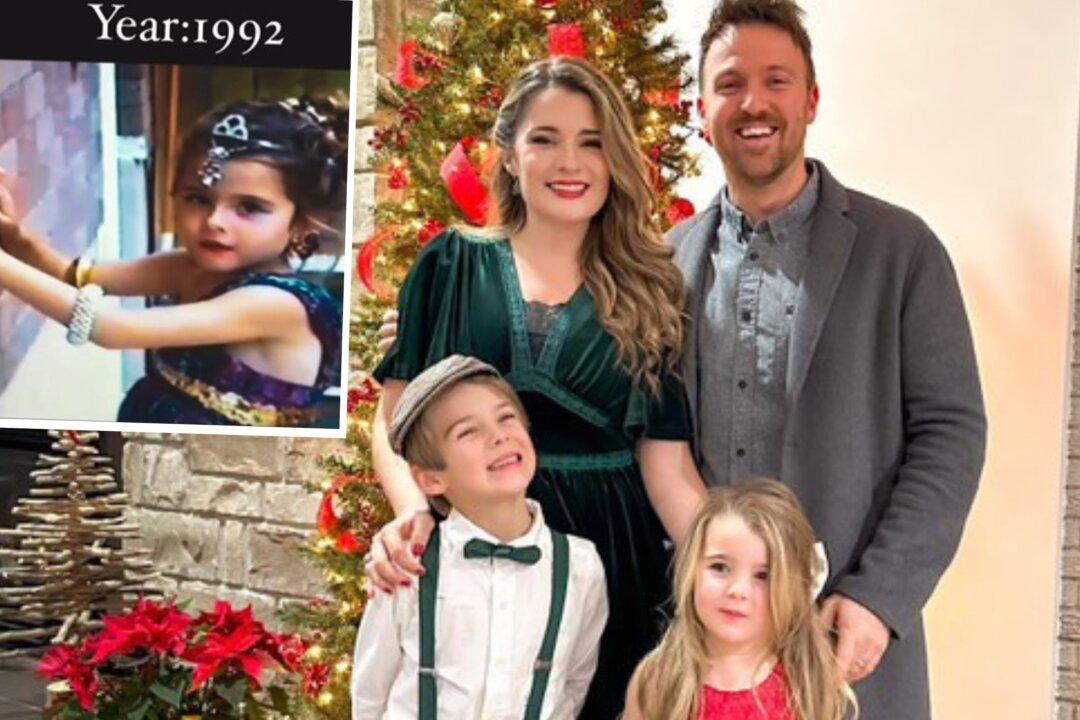Victorian-era enthusiast Katherine Niven shares how she grew her hair long and lustrous. The 28-year-old mother of four from Ontario, Canada, says she owes her own beautiful curly locks to historical hair care.
After a lifetime of treating her hair the modern way, six years ago Niven decided to radically change her routine.
The very first thing she did, was cut her hair “very short.” Fed up with split ends and breakage, starting afresh seemed the best thing to do. Next, Niven stopped using commercial hair products and switched to washing her hair with rhassoul clay. She also stopped detangling her hair while wet and began using a boar bristle brush.
Now, several years on, Niven’s hair has grown from her chin down to her hips. Stronger and glossier than ever before, her hair is now her crowning glory; but Niven says there was a long period of transition first.
“For a while, my hair was actually looking worse than it had before,“ she told The Epoch Times. ”That was partly because I still didn’t know how to care for my hair yet without using all this expensive conditioner and styling products.”


Ancient Hair Care
Taking inspiration from the way Victorian women treated their hair, the avid content creator—who runs popular YouTube and Instagram channels primarily focused on Victorian dressmaking techniques—found wisdom in a gentler approach to hair care. Noting how historically women typically had much longer hair than people today, Niven figured that they must have been doing something right.Niven said: “Since they didn’t have access to modern running water and weren’t bathing very often, they weren’t relying on washing their hair every day.
“So instead, they learned to care for their hair when it was dry using more low-tech methods such as using a bristle brush every night to brush out their hair, which does a very good job of cleaning any dust or debris out of the hair, as well as distributing the oils.”


https://youtu.be/k-2YxqGiI54
Since Victorian ladies didn’t have hairdryers either, the modern mom and homemaker stopped using heat on her hair—except on the odd occasion when she’s running late.
“I view my hair as a living thing, like a plant,” she said. “And just like how I wouldn’t want to use heat on houseplants of mine, I don’t want to use heat on my hair strands because it dries them out and makes them more brittle.
“I realize that a lot of people love their heat tools because of the styles they can achieve, but for me, it’s not worth it. I actually think there are a lot of ways to nicely style hair without the use of heat.”
Instead, Niven just wraps her washed hair up in an old cotton t-shirt, like a turban, and leaves it for an hour at most before taking it off and letting her hair air dry. She also doesn’t detangle her hair when strands are wet, she says, because they lose a lot of their strength and are more likely to break.

Be Conscious About Choices
Born with naturally very thick, curly hair, Niven remembers hours spent detangling as a child when she’d be crying in pain. And because she was the only kid in her class with such curly hair, says Niven, she was often teased in school.By the time she was a teenager, all Niven wanted was to fit in with her peers, which meant turning to a whole barrage of off-the-shelf lotions and potions that promised to tame the frizz.
“I relied on just spending lots of money buying all these products, using them as a way to mask my natural hair and force it into what I wanted it to look like,” she said. “Even when I went to summer camp, which was a very rustic camp where we would just be in the lake, I had to bring all my products with me. If I didn’t have all of my products to cope with my hair, I was very insecure about it.”

https://youtu.be/BUGS_K6E-Oo
Besides losing confidence, Niven grew increasingly frustrated that despite wanting long hair and not cutting it, her hair would only reach a certain length. It was only when she had her first child that she started to become more conscious about chemicals and rethink the products she wanted to be using on a daily basis.
“At that point, I stopped using all those products and set out on my journey of discovering how to care for my hair naturally,“ she said. ”I was so reliant on those products, but the way most commercialized products work is they don’t actually improve the health of the hair itself—they just create a mask of health, because they’re coating the hair with all sorts of things and maybe making it look a bit shiny.”
Niven also came to realize that the way she was treating her hair was causing weakness, and preventing real growth.
“There was a general lack of love in the way that I handled my hair,“ she said. ”I was all about not liking my hair, and I think that translated into just being overly rough with my hair, not taking care of it.”
Now, Niven basically uses mineral-rich rhassoul clay, which not only cleanses and conditions her hair without stripping away oils, she says, but also helps define her curls. And apart from using oils in her hair care routine, she also rinses her hair with an apple cider vinegar for a healthy shine.
The results speak for themselves.
“It’s made a huge difference for me that my hair is truly healthy on its own,” she said. “They’re stronger, they’re more resilient, and they’re less brittle and less likely to break. I have a lot fewer split ends. And that’s all without having to use a whole bunch of commercial hair products on my head.”

Tips for Strong, Glossy Hair
Niven advises to not make any sudden drastic changes to your hair care or diet, but take the middle path.“I try not to just do something simply because that’s what everyone else does,” she said. “I'd rather like to be more conscious about the choices I make and think them through and make sure it’s something that’s going to be healthy for me.”
Starting with the fundamentals of washing hair the ancient way, she says, using rhassoul clay can take a little bit of trial and error. The mixture shouldn’t be too thick with mud-like texture, but instead, it should be “quite watery.” “A quarter cup of clay powder to two cups of liquid is about right, and is easy to rinse out,” she said. “For all hair types, I do recommend leaving the clay for a minute or two just so it has time to fully cleanse your hair, before you rinse it out.”
Applying oil to hair should make a significant part of one’s hair care routine. Oils should be applied both to the length of the hair and the scalp. “Oils are more individual. People with fine or straight hair are better using a light oil, whereas those with curly hair like mine can use heavier oils like coconut, castor, or olive oil,” she said.
“Watch out for products labelled as ‘natural’ because a lot will simply mix a couple of natural ingredients, like essential oils or some herbal extracts, into a synthetic base, pretty much the same as what is used in a standard product. I’ve learned to love reading ingredient labels at the drugstore.”

Eating right and nutritious foods is equally important. Niven says she has, over the years, learned the value of “eating in a very traditional way.”
“I try to eat a lot of very nutrient dense food, organic food. I eat a lot of eggs, butter, bone broth, I’m into all of that,” she said. “Traditional cultures throughout the world that were living close to nature, [ate] a lot of nutrient-dense foods, and they all had good hair, good teeth, and were just generally very healthy people. So, I generally try to eat organic foods, lots of fruits and vegetables, and I try to avoid processed foods and sugars.
“Perhaps there’s someone reading this article, and they want to grow long hair. Maybe they look at their diet, and see a lot of bad things they’re eating, but it’s important not to all of a sudden cut out all of these things at once, because that could have the opposite effect on your hair.”
Niven says she learned her lessons “the hard way.” To avoid putting your body in a state of panic, it’s always “better to do things in a gradual way.”
“It’s obviously related to your internal health,” she said. “But there are lots of simple approaches that you can do like just topical treatments that can help while you’re dealing with the internal causes of the hair shedding.”







